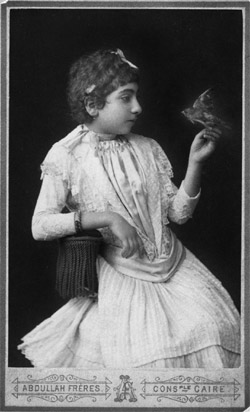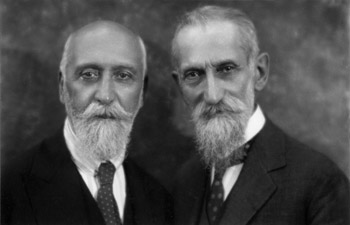
Everyday Immortality
“Now we can definitely say that Armenians played a significant role in the development of photography in theMiddle East,” said photographer Vahan Kochar. He is the editor and publisher of the Encyclopedia of Armenian Photographers that was recently published inYerevan.
The encyclopedia presents significant achievements in Armenian photography, past and present, with some 530 photographers and 800 photographs from the 19 th to the 21 st centuries. There are forty-three pages alone devoted to the stamps of 19 th and 20 th century Armenian photographers.
It was Vahan's father, the well-known photographer Andranik Kochar, who first had the idea of creating an encyclopedia of photographers. This was, however, only a part of Andranik Kochar's original dream. He dreamed of creating a museum university that would present everything related to photography– photographic tools, artists, biographies and the works themselves- but he never managed to turn his dream into reality; it was impossible during Soviet times.
Today it's difficult to generate interest in the arts, as they do not turn a profit. After knocking on many doors and receiving many rejections, Vahan Kochar askedArmenia's then prime minister, Andranik Margaryan, to sponsor the book. The prime minister, understanding the importance and value of the work, graciously provided sponsorship.
“This book is very important, because it's the first, but to say that it provides a complete picture of Armenian photography would be wrong, “ Kochar said, adding that he has already begun work on a four-volume edition of the encyclopedia.
“You research a photographer or a picture and you find many new details underneath. There are little details that you wouldn't even pay attention to, but when you do, you find out that they aren't just little details.”
Vahan offers the example of Grigor Ter-Ghevondyan, who was a photographer fromTiflis. It is due to him that we have photographs such important figures in our culture as Raffi, Mikayel Nalbandyan, Gabriel Sundukyan, Hakob Paronyan, Rafael Patkanyan, and Ghazaros Aghayan. In the chapter on Grigor Ter-Ghevondyan, there are two photographs of Catholicos of All Armenians Krimyan Hayrik. These photographs led to a significant discovery.
 |
 |
“Let me first start with the fact that Ter Ghevondyan's stamp is the only one that contains the year of foundation. On it is written in Russian that the firm was founded in 1864. In addition, Ter Ghevondyan's son was the famous composer Anushavan Ter Ghevondyan. So in the first photograph, Krimyan Hayrik is young, and the photograph is signed A. Ter Ghevondyan. The other picture was taken when Krimyan Hayrik was already Catholicos, with a white beard and three crosses. The photo was signed by G. Ter Ghevondyan. So it becomes clear that Grigor's father, whose name may have been Anushavan, was also a photographer.”
 |
| Abdulahyan Brothers. “Girl with a Bird" |
Kochar is now trying to find out about A. (Anushavan?) Ter Ghevondyan and locate any photographs in his name. Similarly, while looking for information on the Abdulahyan brothers, he discovered that the Patriarch of Jerusalem Esayi Talasetzi was an avid photographer and that he liked the art so much that he founded the Karapetyan Photography Studio on the premises of theHakobyantsChurch. “This studio was open for 17 years, and during those 17 years many famous Armenian and Arab photographers were trained there.”
He found out that the Armenian and Arab photographers studied there through a guidebook written by the patriarch. Though the guidebook was never published, the manuscript has been kept.
In addition to training photographers, the Karapetyan Studio played an important role in spreading the appeal of photography. “Thousands, tens of thousands of pilgrims would come toJerusalemand they would take a photo of themselves to confirm their pilgrimage, and then they would go back to various parts of the worlds with those photographs. So in places where no one had seen a photograph before, people would see one for the first time and learn that there was such a thing.”
When I asked, “Who was the first Armenian photographer?” Vahan Kochar didn't rush to answer. “If we look according to this book, the first were the Abdulahyan brothers, more precisely Vichen Abdulahyan. But you know, working on this there were so many surprises that I'm not yet ready to give you an answer.”
According to Vahan Kochar, during theOttoman Empire, the camera with a wooden tripod was called “an Armenian's device”. This shows the extent of the connection between Armenians and photography. “What do I know, someone might read this book tomorrow and come and say, I'm sorry but the first one was this person, and that someone would bring the photos and the biography too, “ Vahan said.
The four-volume encyclopedia that Vahan Kochar is currently working on can by no means be considered all-inclusive. It's a constantly changing work. “During an exhibition dedicated to the great friend of Armenians Armin Wegner, I saw a photo which, according to the organizers, had been taken by Wegner, but in reality the author was the personal photographer of Persian Shah, Antoine Khan Sevrugin.”
 |
| Antoine Khan Sevrugin. “Punishment for Voicing Disrespect Towards City Authorities” |
This encyclopedia and its future extended version can be a guide for the experts. “If the exhibition organizers had been familiar with Sevrugin's photos, don't you they'd would have a slight doubt about whether the photograph had been taken by Wegner?”
Before there were photographers, people were portrayed by painters. This was an expensive luxury, and only the elite class – nobility and aristocrats—could afford it. Photography was more democratic. Middle class and even working class people could afford it. Besides the fact that anyone could come and have a picture taken, the photographers themselves paid attention to the lifestyles of the different classes in society. For example. Antoine Khan Sevrugin, who was the palace photographer for the Shah of Persia, also had works that today would be considered photojournalism.
 |
| H. Semerchyan. “Doctor and Historian Vahram Torgomyan and His Brother” |
“The man left a great deal of information about the life and lifestyle of Armenians, Jews, Kurds, Dervishes and Persians. We see in his photos how kebab was made on the street, how water was sold, how criminals were executed. And the most interesting thing is no one commissioned this work or paid him for it. He himself understood that it was important.”
The advent of photography brought new faces into society, and accorded them special status. Who was the photographer in the early stages of the art and what was his position in society?
“What position?” Vahan Kochar repeated my question with a certain disdain. “You know, in those times the most important person in the society the doctor who was fighting against disease, that is to say, against death. The photographer, on the other hand, would, snap, take a photo and immortalize people. No more, no less.
To purchase a copy of the Encyclopedia of Armenian Photographers, or if you have any information on Armenian photographers, please write to [email protected].
 Videos
Videos Photos
Photos
Write a comment